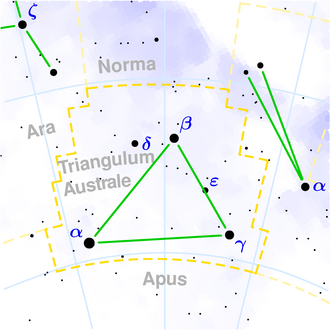NGC 5938
| Galaxie NGC 5938 | |
|---|---|
 | |
| AladinLite | |
| Sternbild | Südliches Dreieck |
| Position Äquinoktium: J2000.0, Epoche: J2000.0 | |
| Rektaszension | 15h 36m 26,3s[1] |
| Deklination | -66° 51′ 35″[1] |
| Erscheinungsbild | |
| Morphologischer Typ | SB(s)bc[1] |
| Helligkeit (visuell) | 10,9 mag[2] |
| Helligkeit (B-Band) | 11,7 mag[2] |
| Winkelausdehnung | 2,8′ × 2,5′[2] |
| Positionswinkel | 177°[2] |
| Flächenhelligkeit | 12,9 mag/arcmin²[2] |
| Physikalische Daten | |
| Rotverschiebung | 0,011709 ± 0,000019[1] |
| Radialgeschwindigkeit | (3510 ± 6) km/s[1] |
| Hubbledistanz vrad / H0 | (150 ± 10) · 106 Lj (46,1 ± 3,2) Mpc [1] |
| Geschichte | |
| Entdeckung | John Herschel |
| Entdeckungsdatum | 9. Juni 1836 |
| Katalogbezeichnungen | |
| NGC 5938 • PGC 55582 • ESO 99-7 • IRAS 15317-6641 • 2MASX J15362626-6651350 • SGC 153147-6641.6 • GC 4107 • h 3605 • | |
NGC 5938 ist eine 10,9 mag helle Balkenspiralgalaxie vom Hubble-Typ SBbc im Sternbild Südliches Dreieck.
Sie wurde am 9. Juni 1836 von John Herschel mit einem 18-Zoll-Spiegelteleskop entdeckt,[3] der dabei „F, S, among a crowd of milky way stars. No doubt ias to its nebulous character. All that is starry in field is clearly resolved“[4] notierte.
Weblinks
- NGC 5938. SIMBAD, abgerufen am 18. Mai 2016 (englisch).
- NGC 5938. DSO Browser, abgerufen am 18. Mai 2016 (englisch).
Einzelnachweise
Auf dieser Seite verwendete Medien
Autor/Urheber: Donald Pelletier, Lizenz: CC BY-SA 4.0
"Image created using the Aladin Sky Atlas software from the Strasbourg Astronomical Data Center and DSS (Digitized Sky Survey) data. DSS is one of the programs of STScI (Space Telescope Science Institute) whose files are in the public domain (http://archive.stsci.edu/data_use.html )"



